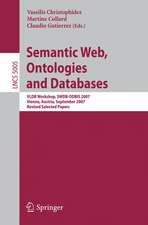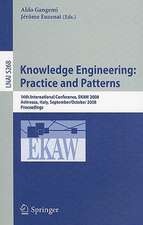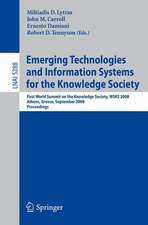Knowledge Representation and Relation Nets
Autor Aletta E Geldenhuys, Hendrik O van Rooyen, Franz Stetteren Limba Engleză Hardback – 31 mai 1999
While the theory of relation nets is dealt with in detail in part of this book, the reader need not master the formal mathematics in order to apply the theory to this method of knowledge representation. To assist the reader, each chapter starts with a brief summary, and the main ideas are illustrated by examples. The reader is also given an intuitive view of the formal notions used in the applications by means of diagrams, informal descriptions, and simple sets of construction rules.
Knowledge Representation and Relation Nets is an excellent source for teachers, courseware designers and researchers in knowledge representation, cognitive science, theories of learning, the psychology of education, and structural modeling.
Preț: 954.69 lei
Preț vechi: 1193.36 lei
-20%
Puncte Express: 1432
Preț estimativ în valută:
169.02€ • 196.81$ • 146.83£
169.02€ • 196.81$ • 146.83£
Carte tipărită la comandă
Livrare economică 23 februarie-09 martie
Preluare comenzi: 021 569.72.76
Specificații
ISBN-13: 9780792385172
ISBN-10: 0792385179
Pagini: 279
Ilustrații: XI, 279 p.
Dimensiuni: 156 x 234 x 18 mm
Greutate: 0.59 kg
Ediția:1999 edition
Editura: Springer Us
Locul publicării:New York, NY, United States
ISBN-10: 0792385179
Pagini: 279
Ilustrații: XI, 279 p.
Dimensiuni: 156 x 234 x 18 mm
Greutate: 0.59 kg
Ediția:1999 edition
Editura: Springer Us
Locul publicării:New York, NY, United States
Public țintă
ResearchCuprins
I Structural Modelling of Knowledge.- 1. Some Approaches to Knowledge Representation.- 2. A Labelled Digraph Model for Knowledge Representation.- 3. Cascades, Formal Schemas, and Derivability.- 4. Knowledge Structures.- 5. Presentation Strategies for CRKS’s.- 6. Accommodations and Analogy.- 7. An Example of Structural Analogy.- 8. Modelling New Knowledge.- 9. Models of Reasoning.- 10. Potential Uses of the Crks Model.- II A CRKS for a Programming Language.- 11. An Example of a CRKS.- III Relation Nets.- 12. Introduction to the Theory of Relation Nets.- 13. Connectedness and Vertex Bases.- 14. Vulnerability.- 15. Connectivity.- 16. Subnets and Factorization.- Appendices.- A- A Partial Model of CRKS Theory.- B- List of Constructional Schemes.- References.


















